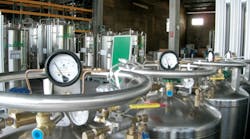This article was originally published in the “2011 Flowmeter Technology Report” issue of Flow Control magazine. To view this issue of Flow Control in its entirety, click here.
It’s human nature to want to see things as right and wrong, good and bad, black and white. But upon further analysis, we often find that whatever the topic we are considering, we can only really see shades of grey. And this is the feeling I’m left with as I put the finishing touches on the “2011 Flowmeter Technology Report” issue of Flow Control magazine. This is to say, when we consider flowmeters in all of their shapes and sizes and benefits and drawbacks, it’s difficult to hold one technology up as the crème de la crème.
The other day I received an e-mail from a reader who took exception with an article we recently published on flowmeter selection strategies because it did not provide enough consideration of Coriolis technology. The reader declared Coriolis as the “Gold Standard” for gas flow measurement and made the case that this technology was deserving of more coverage in the article in question. While I may agree that we should have provided additional detail on Coriolis flowmeters in our article, I’m reluctant to slap the label of “Gold Standard” on any flowmeter. After preparing all of the material you’ll find on the pages that follow, the one theme that sticks with me is that even the oldest and most simplistic flowmeters hold value for certain flow measurement scenarios. For example, did you know:
1. Differential-pressure flowmeters are now commonly outfitted with multivariable transmitters to measure more than one process variable, such as differential-pressure and pressure or temperature. Flowmeters of this sort are becoming increasingly popular for applications where end-users are seeking a low-cost solution for measuring steam or gas flow.
2. Positive-displacement flowmeters remain an attractive and effective solution for certain utility-based flow measurement applications, particularly in scenarios where the end-user is seeking a low-cost option for basic metering needs. PD meters are also a good fit for low-flow gas measurements in smaller line sizes.
3. Turbine flowmeters are a good fit for measuring clean, steady, medium- to high-speed flows of low-viscosity fluids. And while turbine meters face strong competition from newer flowmeter types, such as Coriolis and ultrasonic, they, like many older flow measurement technologies, have the benefit of a large installed base.
4. Variable-area flowmeters are a solid option for end-users who are looking for a low-cost solution for determining flow/no-flow; who need to set an alarm; and/or who what to the check the performance of another flowmeter.
So, while you may be tempted to view more traditional flow measurement technologies as “old hat” when considering them in the light of the advanced technology behind some of newer flowmetering systems, one would be ill-advised to do so. There are certainly applications where all of the bells and whistles offered by Coriolis flowmeters, for example, are beneficial. However, it is important to keep in mind that not all applications call for bells and whistles. After all, we wouldn’t take the new Ferrari to the local garden center to pick up a yard of mulch, would we?
[email protected]
This article was originally published in the “2011 Flowmeter Technology Report” issue of Flow Control magazine. To view this issue in its entirety, CLICK HERE.

